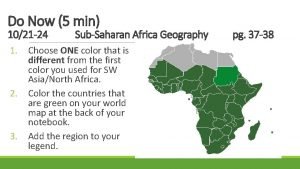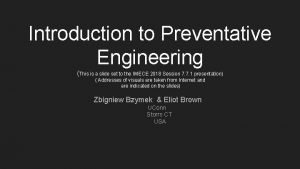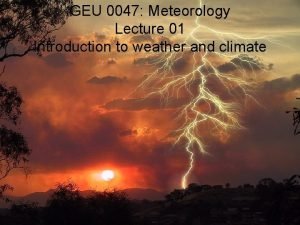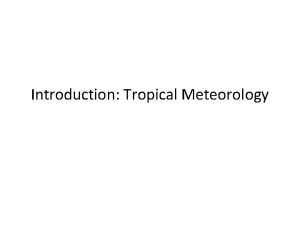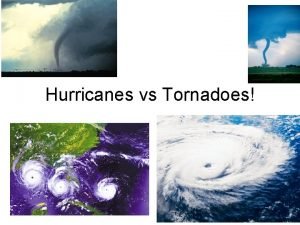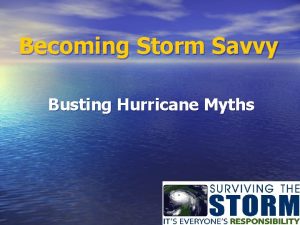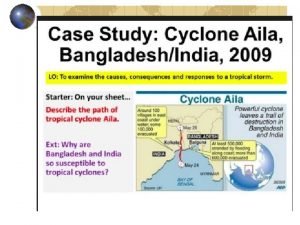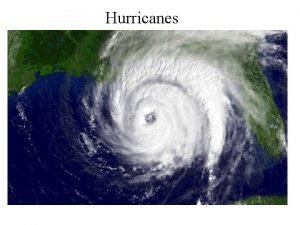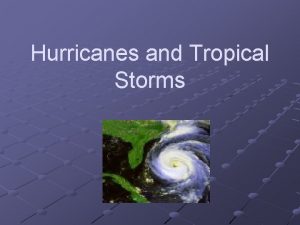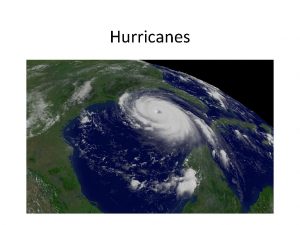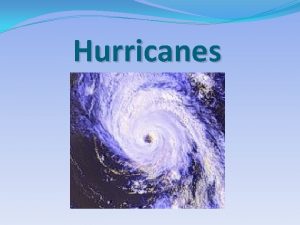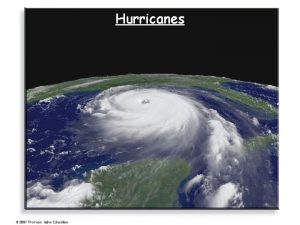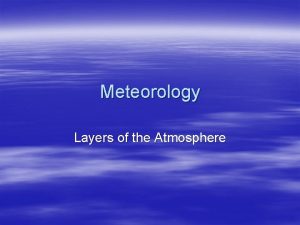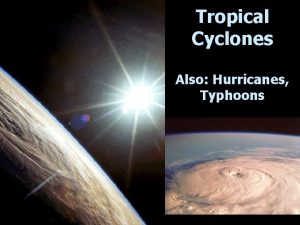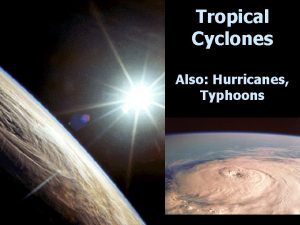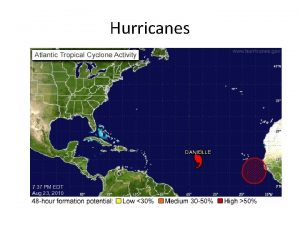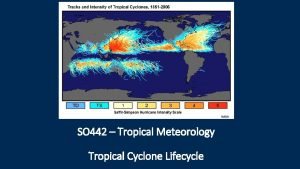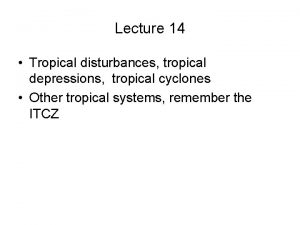Lecture 7 1021 Hurricanes and Tropical Meteorology Tropical












- Slides: 12

Lecture 7 (10/21) Hurricanes and Tropical Meteorology

Tropical Meteorology • Anything between about 30 N and 30 S in latitude • Or between Tropic of Cancer (23. 5 N) and Tropic of Capricorn(23. 5 S) • Fuzzy definition • Radiation budget > 0 in tropics • Job of tropics = export heat poleward

Tropical Meteorology • Very difficult compared to mid-latitudes • Can’t just measure pressure and get an approximate wind field • Geostophic Balance - doesn’t happen in in tropics • Effects of Earth’s rotation not a big player (Coriolis force is small) • Try to measure convergence (winds coming together and divergence- winds pulling apart) to deduce areas of upward motion

Other Problems • Lack of data in tropics • Most of area is not covered with land so less observations • Countries with less advanced obs networks • Best sources for winds are: aircraft reports, wind profilers, reconnaissance flights, satellite-derived wind reports (cloudtagging)

Tropical Cyclone Classification • TC’s form from a wave or disturbance • Trop disturbance = any area of “disturbed weather” ex: stalled out front • Trop wave = elongated area of low pressure (just a trough). Go from East to West (direction of winds at these latitudes). • Trop depression = closed low (trough pinches off) • Trop storm = 39 -73 mph, hurricane=74+

Strength Versus Intensity • Intensity = core region (center to 100 km) • An increase in intensity = stronger max winds or lower minimum surface pressure • Intensity can change quickly • Strength = outer part of core • Associated with area weighted average wind speed outside of core

Eyewall Cycle • Happens in intense hurricanes • Closed rainbands form a bit outside eyewall and move towards eye • Old eye deteriorates from subsidence (sinking air) induced by rainband • Closed rainband becomes new eyewall (most intense when eyewall is well defined) • Intensity changes during this but not strength • Whole cycle repeats itself

Eyewalls & Rainbands • Region of clouds/intense rain/strongest winds that seperates sinking air in eye from rest of storm • Typically not vertical (45 deg slope = common) • Rainbands = stronger areas of rain with higher clouds between them • Sometimes, tornadic supercells will form in rainbands as storm hits land (b/c of added friction)

Inflow and Outflow • Inflow in a TC happens near ocean’s surface (under clouds) in planetary boundary layer • Little known about hurricane inflow • Outflow = usually anticyclonic aloft (upperlevel high) • Anticyclonic outflow helps push out the stable “exhaust” of a hurricane

Fun Facts • Anticyclonic outflow (almost) never displaced toward equatorward side • TC’s need 80 degree Fahrenheit water • TC’s need deep, warm water too (winds stir it up) • recurvature = term for TC switching from Northeastward to Northwestward movement • Usually means the peak for the storm - starts to decay after that • Bill Gray at CSU = hurricane guru - uses climatology and old navy radiosonde data to come up with theory/predictions

Websites FAQ’s from the National Hurricane Center http: //www. aoml. noaa. gov/hrd/tcfaq. HED. ht ml (G 12 & D 7 on FAQ’s) Current Satellite Loops http: //www. cira. colostate. edu/ramm/rmsdsol/TRO PICAL. html Tropical model data output http: //www. essc. psu. edu/~rhart/tcgengifs/ (GFDL) The coolest website ever (shows movie of enhanced satellite imagery of Michelle) (need high speed connection) http: //rsd. gsfc. nasa. gov/pub/goes/QTmovies/0111. michelle. mov

For Next time: • Mid-semester gift. No reading assignment. We will be discussing Radar next week and the book does not have anything useful to read about it. • However, still be sure to do Homework 7 (Hurricanes and Tropical Meteorology) • We will still have the quiz next week
 1021/24
1021/24 Hurricanes tropical storms
Hurricanes tropical storms Knots si unit
Knots si unit Introduction to tropical meteorology
Introduction to tropical meteorology Introduction to tropical meteorology
Introduction to tropical meteorology Tornado and hurricane venn diagram
Tornado and hurricane venn diagram Compare and contrast signal words
Compare and contrast signal words 01:640:244 lecture notes - lecture 15: plat, idah, farad
01:640:244 lecture notes - lecture 15: plat, idah, farad Hurricanes vs tornadoes
Hurricanes vs tornadoes Hurricanes myths and facts
Hurricanes myths and facts Distribution of tropical storms
Distribution of tropical storms How are hurricanes categorized
How are hurricanes categorized Hurricanes definition
Hurricanes definition
